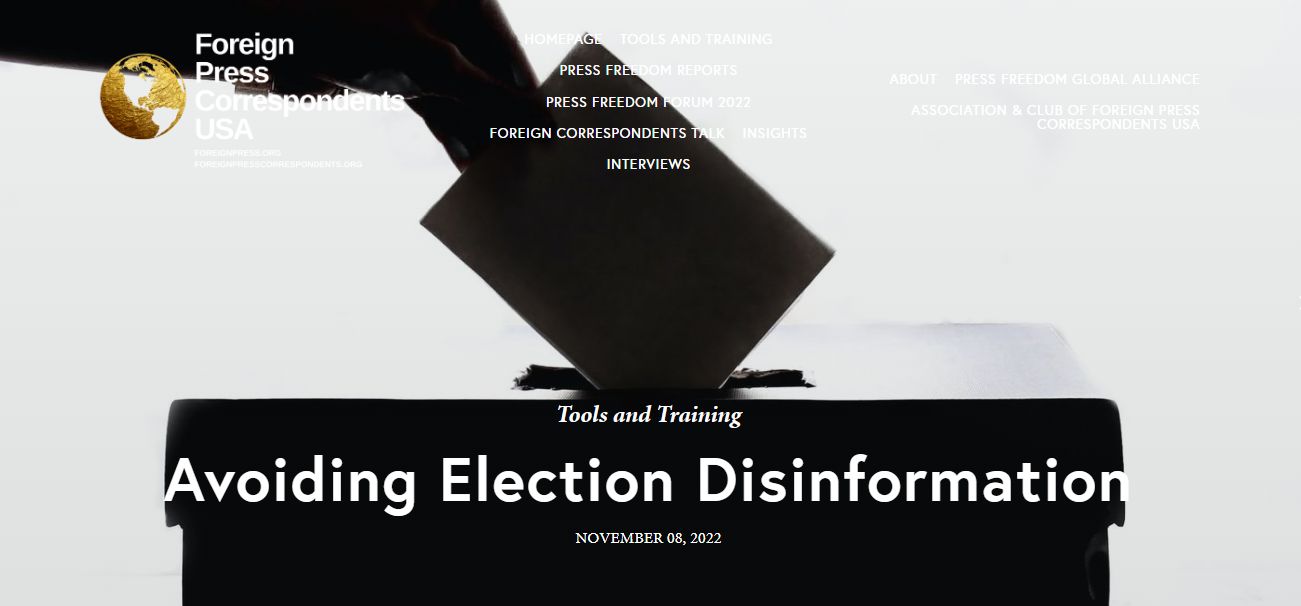The editor of CCO Magazine would like to draw readers’ attention to the article published by the foreignpress.org: “Unfortunately, the past few years have made it clear that disinformation campaigns target United States election cycles very heavily. With another election coming up today, the internet is once again saturated with false claims, doctored videos, and misleading information and disinformation about voting. “
CCO COLLECTION – OTHERS WROTE, WE QUOTE
Avoiding Election Disinformation
Unfortunately, the past few years have made it clear that disinformation campaigns target United States election cycles very heavily. With another election coming up today, the internet is once again saturated with false claims, doctored videos, and misleading information and disinformation about voting.
Thankfully, there are some go-to ways to catch these seeds of chaos before they bloom, and to begin to de-weed misinformation from the cluttered Twitter feeds or TikTok pages that pump them out.
Here are some valuable tips.
CHECKING USERS’ PROVIDED INFORMATION
Most social media accounts will require a profile with some sort of information—names, pronouns, occupations, etc. Accounts being used to push misinformation usually will have some sort of major red flag in their profile. The most common red flag is having no information available whatsoever—a blank profile could be a burner account or a bot, and it’s safe to assume that those are unreliable sources. Moreover, scam accounts will sometimes have links to their latest cryptocurrency schemes or something of the like–legitimate accounts will not try to lure you into something ulterior.
SOURCE PICTURES
Reverse Google image search, which lets you find out how and where a photo has been shared, is your best friend here. One should never take an image at face value online, and verifying its source is only step one. Since misinformation can spread so quickly, really tracing the source and verifying the context of that picture is crucial to your research process. Images are often taken out of context as a form of disinformation by bad actors.
VERIFY INFORMATION FROM SEVERAL SOURCES
It is very rare that any credible news regarding the election cycle will only make it to one platform–most credible sources will report their own version of that information, and more sources can be culled and utilized from scouring multiple articles. A new phenomenon–known as “deep fakes” and “cheap fakes”–make this especially vital. Information may not be verifiably false on site anymore, and videos and photos make a large impact on the public, and fact-checking and researching these is vital to the health of the spread of information.
POLLS ARE IMPORTANT—AND UNTRUSTWORTHY
Understanding how to read polls is in and of itself an Olympic sport. On top of that, polling includes a lot of errors. Polls most certainly are valuable in gauging how the media engages with the public, and how the public is responding to the media. But voting conditions are changing constantly. Several states have passed new laws in the wake of the 2020 election, making it harder or more inaccessible to vote—meaning who is and is not a “likely voter” is changing. A new generation has also reached voting age since the last election. So many variables show up in the face of an election, and while polling can be useful to get a handle on basic public opinions, polling is not something that should be represented as “fact” or a “sure thing.”
REMEMBER TO SHARE THE CORRECT INFORMATION
A lot of the focus today is on fact-checking, with good reason: the former President of the United States lied so often that over 30,000 of his statements while in office were labeled false or misleading. Several politicians have taken this and run with it, meaning several bad actors who spread election disinformation are actual candidates who have the most to gain from it. Refuting this information is important—but so is correcting it. The public needs access to proven, verifiable information, and it is our job as journalists to make that process as painless as possible. Accompanying a fact-check with a little blurb on the correct facts, your sources, and any other relevant information is a must.
Election season brings a storm of new headlines daily. It’s important to keep our eyes on these so that we can begin nipping misinformation in the bud and making sure it doesn’t spread any further, by, as always, sharing our best practices with the public.
Source:
This article is a republication. It is re posted from foreignpress.org media portal, with the permission of the editorial office.
